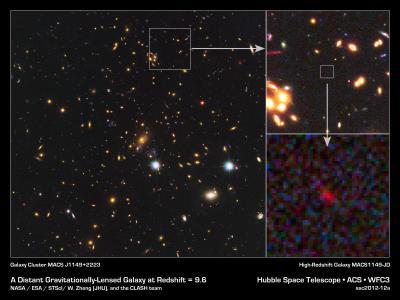Science News
Most Distant Galaxy?
September 20, 2012

Astronomers have caught a glimpse of a galaxy far, far away—possibly the most distant ever observed.
The galaxy, dubbed with the melodic name MACS 1149-JD, was spotted using the combined power of NASA’s Spitzer and Hubble space telescopes as well as the phenomenon of gravitational lensing – using the gravity of nearer massive galaxies to bend and magnify the light of more distant ones behind them, which would otherwise remain invisible.
Small and compact, the galaxy appears to contain the equivalent of only about 1 percent of the Milky Way’s mass. The galaxy is quite young, only about 200 million years old, but we see it far back in time, when the Universe was quite young. (Imagine looking at an old photograph of your great grandparents: an old image showing a perhaps quite young couple.) Light from the young galaxy captured by the orbiting observatories shone forth when the 13.7-billion-year-old Universe was just 500 million years old.
MACS 1149-JD existed during an important era when the Universe began to emerge from the cosmic Dark Ages. During this period, the Universe went from a dark, starless expanse to a recognizable cosmos full of galaxies. The discovery of the faint, small galaxy opens up a window into the deepest, remotest periods of cosmic history.
“This galaxy is the most distant object we have ever observed with high confidence,” says Wei Zheng, lead researcher on a paper appearing in Nature this week. “Future work involving this galaxy—as well as others like it that we hope to find—will allow us to study the universe's earliest objects and how the Dark Ages ended.”
According to leading cosmological theories, the first galaxies should have started out tiny like MACS 1149-JD. They then progressively merged, eventually accumulating into the sizable galaxies of the more modern universe.
These first galaxies likely played the dominant role in the “epoch of reionization,” the event that signaled the demise of the universe's dark ages. This epoch began about 400,000 years after the Big Bang when neutral hydrogen gas formed from cooling particles. The first luminous stars and their host galaxies emerged a few hundred million years later. The energy released by these earliest galaxies is thought to have caused the neutral hydrogen strewn throughout the Universe to ionize, or lose an electron, a state that the gas has remained in since that time.
Astronomers plan to study the rise of the first stars and galaxies and the epoch of reionization with the successor to both Hubble and Spitzer, NASA's James Webb Telescope, which is scheduled for launch in 2018. The newly described distant galaxy likely will be a prime target.
Image: NASA/ESA/STScI/JHU